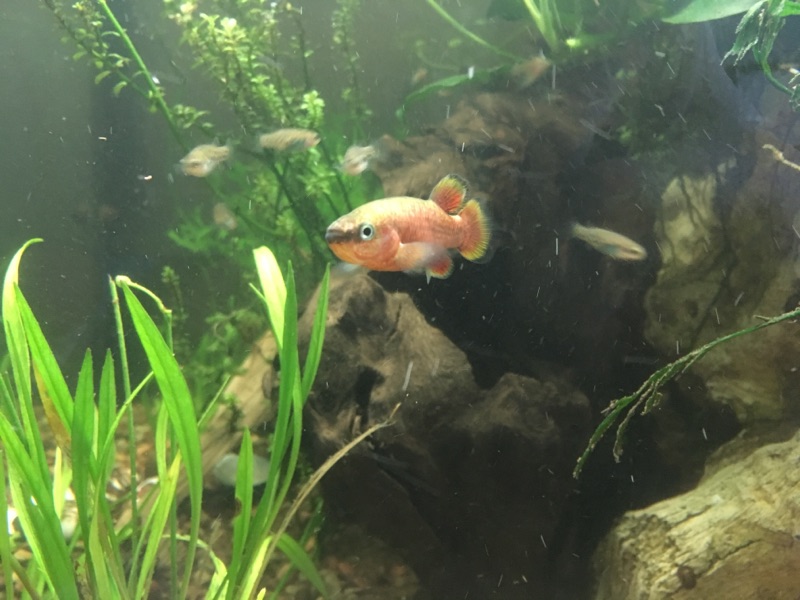
Characodon Lateralis
(This post described my freshwater fish setups in 2016-2018.)
"Old Grandpa" was the oldest male of my family of Characodon Lateralis "Los Berros" (aquarium strain) in Denver, CO, USA.

Their numbers and habitats are declining rapidly in the wild. In the 1950s, they could be found in approximately fifty different locations in western Mexico, and today they can be found in nine.
While not widely available, they are hearty, beautiful, and full of personality. Raising these fish in a home aquarium or pond is an easy and important way to contribute to their conservation.
Overview
These are a fairly small river fish, 2-2.5" adult size. Coloration depends a bit on when and where they were originally collected, but females tend to be silver-brown with spots along their sides and males tend to be partly to fully red, some with black on the edges of the dorsal, caudal, and anal fins. Some also have a band of yellow, as in the photo above.
I was fortunate to receive a pair in the fall of 2016 from Larry Brown (Colorado Aquarium Society). That pair bred, and as of March 2017 I had one adult male and fifteen juveniles.
My Environments
I maintained a 30-gallon indoor aquarium, and two small outdoor ponds (tubs) from May through September. I moved some fish outdoors in the summer, and brought them in when the weather turns colder.
My indoor aquarium was unheated, and had a lot of wood and live aquatic plants. I'm as much a gardener as a fishkeeper. I originally set it up with the plants in mind, so it has plant-friendly substrate and a good plant light. I favor low-tech environments, and I don't run CO2.
My outdoor ponds were a 50-gallon above-ground decorative pond on our deck (rigid plastic form mounted in a custom wooden frame) and a 100-gallon above-ground rubbermaid oval tub. Both had a variety of aquatic plants.
Species Information
The species Characodon Lateralis was originally described by A. Guenther in 1866. Lateralis means "on the sides" and refers to the visible stripe/spots on the sides of the fish. It is also known as the "Rainbow Characodon" in the hobby, and is called "Mexclapique arcoiris" in Mexico.
They are a cold-water fish, at least compared to many of the "tropicals" in the US aquarium hobby. Their temperature range is 18°C - 27°C (65F - 80F). I keep mine at "room temperature" when indoors at our home, which is on the lower end of that (65-70F).
They are livebearers (as opposed to egg-layers) in the Goodeid family. Traditionally, these are three species identified within the Characodon genus: C. Lateralis, C. Audax (also endangered), and C. Garmani (extinct). There is some discussion in the field currently about whether audax and lateralis are genetically identical, or are in fact the same species. (Scientific understanding is not so static, after all.)
In my aquarium, they enjoyed plants and little nooks and crannies to explore and defend. Both sexes chase one another, but largely leave the other fish in the tank alone (in my case, tankmates are tiny Heterandria Formosa). They are curious and would often approach the aquarium glass when I was nearby.
Conservation
C. Lateralis is losing its home territory quickly, in western Mexico. Human development, pollution, and habitat takeover by invasive species has reduced their originally-known range from fifty locations to nine, and most of those are at risk. Keeping C. Lateralis in home and school aquariums is an easy and powerful way to participate in their conservation, and help preserve global biodiversity. Preserving Goodeid species is a conservation effort that is important to zoos and aquariums all over the world, and you can be a part of it!